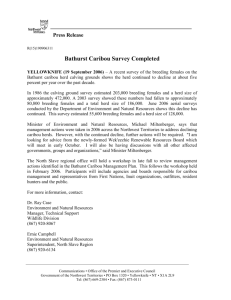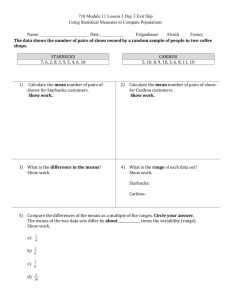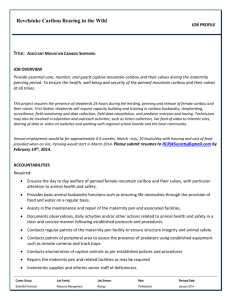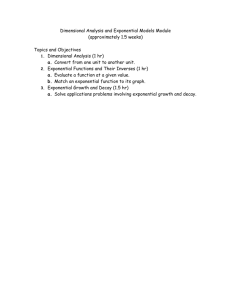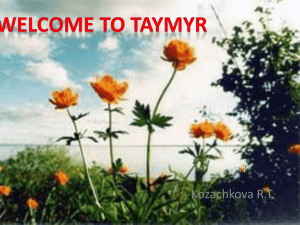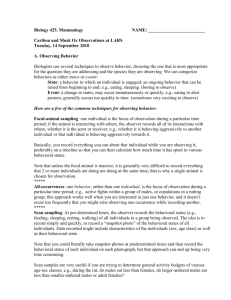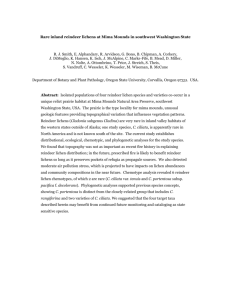~ .~ NOTES FOR THE GAME FARMING ... :~
advertisement
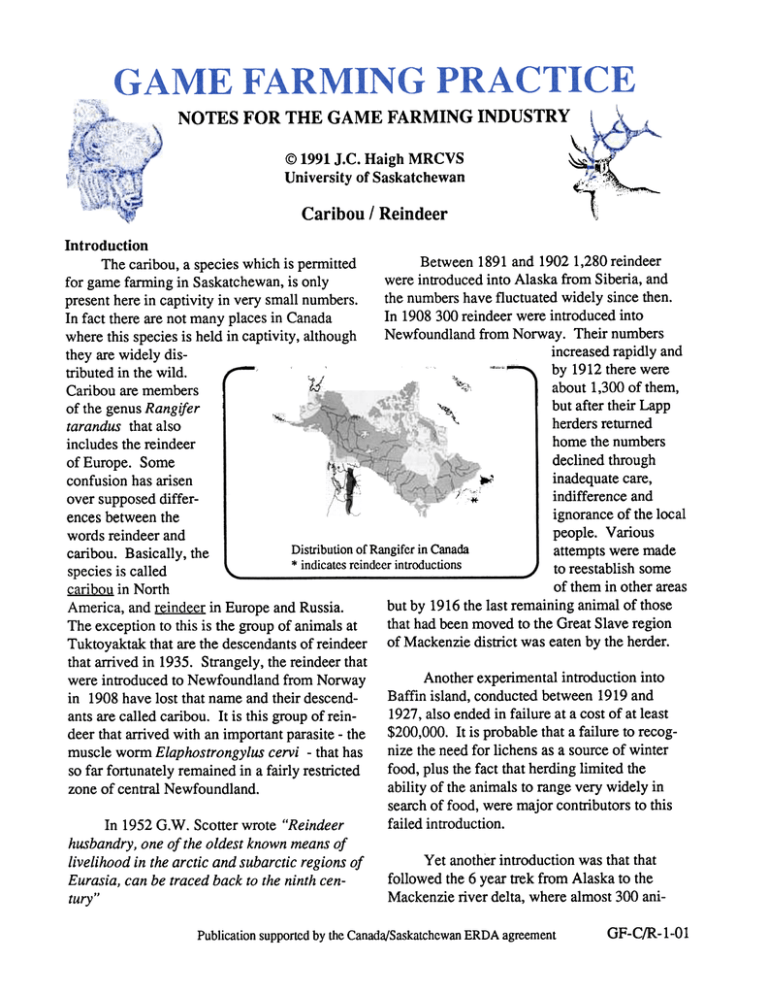
\.
~
NOTES FOR THE GAME FARMING INDUSTRY
@1991 J.C. Haigh MRCVS
University of Saskatchewan
Caribou / Reindeer
~
.("
.~
-Ii!
:~
""1"
Introduction
The caribou, a species which is permitted
for game farming in Saskatchewan,is only
present here in captivity in very small numbers.
In fact there are not many places in Canada
where this species is held in captivity, although
they are widely distributed in the wild.
Caribou are members
j
Between 1891 and 1902 1,280 reindeer
were introduced into Alaska from Siberia, and
the numbers have fluctuated widely since then.
In 1908300 reindeer were introduced into
Newfoundland from Norway. Their numbers
increased rapidly and
~,by 1912 there were
about 1,300 of them,
but after their Lapp
of the genusRangifer
herders
returned
tarandus that also
home the numbers
includes the reindeer
declined through
of Europe. Some
~'1
inadequate care,
confusion has arisen
) /',t,
indifference and
c*
over supposeddifferignorance of the local
ences between the
people. Various
words reindeer and
Distribution
of
Rangifer
in
Canada
attempts were made
caribou. Basically, the
* indicatesreindeerintroductions
to reestablish some
species is called
of them in other areas
caribou in North
but by 1916 the last remaining animal of those
America, and reindeer in Europe and Russia.
that had been moved to the Great Slave region
The exception to this is the group of animals at
of
Mackenzie district was eaten by the herder.
Tuktoyaktak that are the descendantsof reindeer
that arrived in 1935. Strangely, the reindeer that
Another experimental introduction into
were introduced to Newfoundland from Norway
Baffin island, conducted between 1919 and
in 1908 have lost that name and their descend1927, also ended in failure at a cost of at least
ants are called caribou. It is this group of rein$200,000. It is probable that a failure to recogdeer that arrived with an important parasite -the
nize
the need for lichens as a source of winter
muscle worm Elaphostrongylus cervi -that has
food, plus the fact that herding limited the
so far fortunately remained in a fairly restricted
ability of the animals to range very widely in
zone of central Newfoundland.
searchof food, were major contributors to this
failed introduction.
In 1952 G.W. Scotterwrote "Reindeer
husbandry, one of the oldest known means of
Yet another introduction was that that
livelihood in the arctic and subarctic regions of
followed the 6 year trek from Alaska to the
Eurasia, can be traced back to the ninth cenMackenzie river delta, where almost 300 anitury"
Publicationsupportcdby the Canada/Saskatchewan
ERDA agreement
GF-C/R-I-OI
mals arrived in 1935. Of these, only 10% were
from the herd that had originally left Alaska,
90% having been born on the trail. It is the
descendantsof this herd that is currently maintained in and around Tuktoyaktak, although
there is good evidence to show that they have
interbred freely with the caribou of the Bluenose
herd, a group with which they sharerange for
part of the year.
There is a considerable history of failure
of reindeer ranching in Canada. The reasons are
not entirely clear, but may well be related to
nutrition, as the dietary requirements of the
species are highly specialized, and they require
enormous tracts of land when managed in a
grazing system.
Wild European reindeer provide one of the
largest supplies of wild meat anywhere in the
world. They are harvested annually in Russia
during their migrations, and field abbattoirs are
used for dressing and inspection. In 1981-82
over 5,000 tonnes was harvested in this manner.
The meat is all consumed locally and does not
reach the export market. Domesticated reindeer
is also a large industry in Russia. It is estimated
that at least 41,900 tonnes is harvested each
year. In this situation the animals are managed
in a loose herding system and allowed to range
very widely. Some cooperatives support over
12,000 head. The Fennoscandian reindeer
harvest yields almost 7,000 tonnes of meat
annually.
Antlers
A character that distinguishes reindeer
from any other member of the cervidae is the
fact that both males and female carry antlers.
Those of the male are much larger than the
female's, and they are cast at different times of
the annual cycle. The pattern for males is very
similar to that for other deer species from temperate zones, in that velvet growth occurs
through the summer months, and hard antler is
seenfrom late summer until after the rut, although some males may even cast before the
GF-C/R-I-O2
end of the rut. Females on the other hand will
continue to bear hard antler throughout pregnancy, and usually cast at about the time of
parturition. The honnonal events in the antler
cycle of reindeer remain to be clearly shown.
One apparent advantage offered by reindeer over other deer speciesis that velvet antler
is available from both sexes. Harvesting criteria
do not appear to be as rigid as they are for
animals such as wapiti or red deer, but a market
does exist, and the use of reindeer antler is well
documented in Russia.
Handling
Reindeer can be readily handled in chutes,
and large numbers of them are velveted under
such restraint in the extensive operations in
Alaska, Tuktoyaktak and in Russia. There is
however no example of the use of drop floor or
other chutes on farms. Drug immobilization of
caribou is also a potential method of restraint. I
have used several of the drugs that are commonly employed for wapiti, such as xylazine,
xylazine with ketamine, or opioids such as
carfentanil or M99, all with success.
r
the herds, and ensures that a good proportion of
the calf crop survives. In this regard the caribou
employs the same strategy as the wildebeest of
the great plains of East Africa. Certainly, if
wildebeest calves are born early virtually all of
them are taken by the attending lions and hyenas. However, in captivity, the calving season
is not as tightly synchronized, and females
managed without males may cycle several times
during the fall and early winter. The gestation
period is generally reported to be about 225-235
days. The young are born very vigorous, and
are usually able to follow their mothers within
an hour of birth.
Nutrition
In the wild caribou have available a very
wide variety of forage. At least 62 species of
lichen & 282 kinds of seed plants are known to
fonD part of their diet in North America alone.
It is obvious that a potential farmer cannot hope
to meet this kind of variety. In captivity, limited infonnation would indicate that caribou
thrive on a standard hoofstock diet of good
quality hay and fonnulated pellets, but this is an
expensive method of feeding them. They will
graze available grasses, and are particularly fond
of woody browse such as willow. I have seen a
group of caribou that were managed in this
manner for a number of years. One unusual
feature was that by the age of about 2 or 3 years
all incisor teeth were worn to the gum line. The
reasons for this are not clear, but one possibility
is that grazing on grass ensured that a certain
amount of soil was taken with each mouthful
and the soil acted as a rasp to wear down the
teeth.
Diseases
Reproduction
('
In the wild caribou have a very short
breeding season, with an entire herd calving
inside about a 10 day period. This is thought to
be a strategy to ensure survival of a maximum
number of calves, as the sudden mass of young
simply overwhelms the predators that follows
There are some diseasesthat give federal
and provincial authorities considerable concern
when the subject of possible introduction of
these speciesis raised. Throughout much of the
range of the barren ground caribou brucellosis
due to Brucella suis type 4 is found. This
diseasecausesa variety of pathological conditions which include arthritis and bursitis as well
GF-C/R -1-03
as reproductive failure and abortions in females,
and orchitis in males. The diseaseis not known
from eastof Hudson's Bay, which is the eastern
limit of the barren ground caribou, herds in
Quebec being considered to be woodland caribou.
Another diseaseis besnoitiosis that has
been found in caribou almost everywhere that it
has been looked for, including Alaska, several of
the barren ground populations in Canada, and in
a well documented instance in zoo animals in
Winnipeg. In this last case it appears that European reindeer were infected with the parasite,
showed no clinical signs, and transmitted it to
North American caribou as well as mule deer.
Both caribou and mule deer died in the outbreak,
but the method of transmission was never satisfactorily established.
A third concern is a herpes virus infection
of reindeer in Europe that has been shown to
able to cause disease in cattle. This diseasehas
some similarities to Infectious Bovine
Rhinotracheitis of cattle, but is distinct from it.
Caribou are particularly sensitive to infection with the meningeal or brain worm
Parelaphostrongylus tenuis (GF-S-2), and it is
this parasite that has been implicated in the
disappearanceof the species from Nova Scotia.
Several reintroductions of caribou into the
region have subsequentlyfailed, probably because of the presence of white-tailed deer and
the fact that they carry the worm.
biologically sound use of a renewable resource",
but he also considered that it has not contributed
its full potential to the economy of North
America. Although reindeer herding under
extensive managementis well established in
Alaska, Russia and Fennoscandia,there is not
enough information on the managementof the
species under intensive farm, or even semiintensive ranch conditions to allow a clear
conclusion on the potential of Rangifer to
become an economically viable agricultural
animal in southern temperate zones of the world.
Bibliography
A.T. Beregrud. 1978. Caribou. In Big
Gameof North America. Schmidt,J.L. and
D.L. Gilbert (eds). StackpoleBooks.
Harrisburg. Pa. pp: 83-101.
F.L. Miller. 1982. In Wild Mammals of
North America. Chapman, J.A and G.A.
Feldhammer (eds). The Johns Hopkins University Press. Baltimore. 923-959.
Scotter,G.W. 1952. Reindeerranchingin
Canada.J. RangeManage. 25: 167-174.
Hudson,R.J.,Drew, K.R. andL.M.
Baskin. 1989. Wildife ProductionSystems.
SectionD. -Herding, Reindeerhusbandryin the
SovietUnion. (L.M. Baskin); Reindeerhusbandryin Fennoscandia.(S. Skjenneberg);
Reindeerhusbandryin North America. (G.W.
Scotter); 188-241.
In the north, warble flies, Oedmagena
tarandi and nose bots Cephenomyia trompe,
particularly the former, are serious pests for
caribou, and in the summer months they may
spend much of their time in avoidance behaviour. It is the warbles that render the hides of
caribou virtually worthless.
Conclusion
Scotter, writing this time in 1989, stated
that "The reindeer industry is an intelligen t and
GF-C/R-1-04
@
